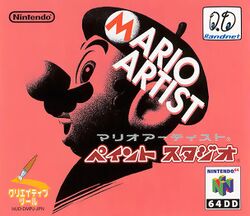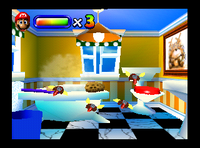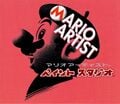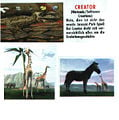Mario Artist: Paint Studio: Difference between revisions
mNo edit summary |
No edit summary |
||
| (111 intermediate revisions by 48 users not shown) | |||
| Line 1: | Line 1: | ||
{{ | {{italic title}} | ||
|image=[[ | {{more images|Screenshots of all gameplay modes}} | ||
|developer=[[Nintendo]] | {{game infobox | ||
|image=[[File:MAPaintStudio.jpg|250px]] | |||
|developer=[[Nintendo EAD]]<br>{{wp|Software Creations}} | |||
|publisher=[[Nintendo]] | |publisher=[[Nintendo]] | ||
| | |release={{release|Japan|December 11, 1999}} | ||
|genre=Creative | |genre=Creative | ||
|modes=Single player, multiplayer | |modes=Single player, multiplayer | ||
|ratings= | |ratings={{ratings|cero=A}} | ||
|platforms=[[Nintendo 64DD]] | |platforms=[[Nintendo 64DD]] | ||
|media= | |media={{media|64dd=1}} | ||
| | |input={{input|n64mouse=1}} | ||
|input= | |||
}} | }} | ||
'''''Mario Artist: Paint Studio''''' (マリオアーティスト ペイントスタジオ) is a game released on December 11, 1999 for the [[Nintendo 64DD]], as part of the [[Mario Artist (series)|''Mario Artist'' series]]. It was one of the only games released for the system and was never popularized as a result. ''Mario Artist: Paint Studio'' is considered the spiritual successor to the [[Super Nintendo Entertainment System]] title ''[[Mario Paint]]'', as both games are graphics editors that came bundled with a mouse controller, making the games resemble art programs used on a computer. | |||
'''''Mario Artist: Paint | ''Mario Artist: Paint Studio'' was primarily developed by British developer {{wp|Acclaim Studios Manchester|Software Creations}}, who had a stable relationship with [[Nintendo]] and had earlier assisted in the development of the [[Nintendo 64]] console. Nintendo took full control of the game's development during its final stages. Due to the failure of the 64DD in Japan, the game, along with the rest of the ''Mario Artist'' suite and the 64DD as a whole, were never released in the {{wp|Western world}}. | ||
[[ | |||
''Mario Artist: Paint Studio'' | ==Gameplay== | ||
< | The game has four modes, total. The modes are as follows: | ||
{{ | *2D Paint, for traditional painting like in ''Mario Paint''. There is a unique four player drawing mode where four players could collaborate to make one drawing together. Pre-existing pictures of some other [[Nintendo]] characters could be used and manipulated on screen, and additional images could be imported from an {{wp|RCA connector|RCA}} source using the [[Nintendo 64DD#AV-In Cartridge|{{conjectural|capture cartridge}}]] or a [[Game Boy Camera]]. The stock Nintendo-themed graphics include all [[bulbapedia:List of Pokémon by Kanto Pokédex number|first 151 Pokémon]], and various renders from ''[[nwiki:Banjo-Kazooie|Banjo-Kazooie]]'', ''[[zeldawiki:The Legend of Zelda: Ocarina of Time|The Legend of Zelda: Ocarina of Time]]'', ''[[lylatwiki:Star Fox 64|Star Fox 64]]'', ''[[nwiki:Pilotwings 64|Pilotwings 64]]'', ''[[nwiki:Wave Race 64|Wave Race 64]]'', ''[[Diddy Kong Racing]]'', ''[[Super Mario 64]]'', ''[[Mario Kart 64]]'' and ''[[Yoshi's Story]]''. There are much more additional pre-made stock images, such as animals and food. | ||
*Animate, which can be used to create multiple frame animations in a flipbook type format. The max amount of frames for these animations are 35 frames long. It was possible to import animated figures into a player's city as a citizen in ''[[nwiki:SimCity 64|SimCity 64]]''. | |||
*3D World, where players can explore various worlds and interact with it. The player can explore three worlds: Mars, Underwater and Dinosaur Land. The player can travel through these environments and take pictures of the creatures who inhabit it. This feature is similar to ''[[bulbapedia:Pokémon Snap|Pokémon Snap]]''. In addition, players can edit the environment's textures, adding their own drawings and creations to surfaces. Once a photo is taken of a creature, the player is also given the ability to edit their textures. | |||
*Gallery, acts as a sort of slideshow. The player can create a slideshow of their images with music. | |||
''Mario Artist: Paint Studio'' is also the only Nintendo 64DD game to use the [[Transfer Pak]]. | |||
==Development== | |||
Software Creations was commissioned by Nintendo in 1995 to create a sequel to ''Mario Paint'' in 3D for the [[Nintendo 64]]. It was initially pitched as a 3D "living playground" called ''Creator'' where the user edits the attributes of premade models such as dinosaurs—playing with sizes, behaviors, aggression, speed, and texture design. It was then re-named ''Mario Paint 64''<ref>{{cite|author=IGN Staff|url=www.ign.com/articles/1997/07/30/miyamoto-reveals-secrets-fire-emblem-mario-paint-64|title=Miyamoto Reveals Secrets: Fire Emblem, Mario Paint 64|date=July 30, 1997|publisher=IGN|accessdate=May 17, 2024}}</ref> and later to ''Picture Maker'' (shown at Nintendo's Space World 1997 trade show in November 1997), with the last working title being ''Mario Artist & Camera''. Nintendo's Japanese departments eventually took control of the project, rejecting many of Software Creations' and Nintendo of America's ideas, before finally releasing the game in December 1999. | |||
According to an image shared by Nintendo of America's Twitter account on [[Mario Day|Mar10 Day]] 2023, the [[Mario's face|Mario face]] in ''[[Super Mario 64]]'' was taken from the prototype of what eventually became ''Mario Artist: Paint Studio'',<ref>{{cite|author=Nintendo of America|url=x.com/NintendoAmerica/status/1634252793795039232|title=Happy #MAR10DAY! With a #NintendoSwitchOnline + Expansion Pack membership, you can celebrate it the Mario way – with some classic, cap-raising adventures! Experience several of Mario’s fantastic firsts across the NES, Super NES, Game Boy, Game Boy Advance, and Nintendo 64 today!|publisher=X|language=en-us|accessdate=March 10, 2023}}</ref> previously referred to by [[Shigeru Miyamoto]] as ''Mario Paint 3D''.<ref>{{cite|url=shmuplations.com/mario64|title=Super Mario 64 – 1996 Developer Interviews|publisher=shmuplations|accessdate=January 27, 2022}}</ref> | |||
===Prototype "''Gnat Attack''"=== | |||
[[File:Mario-artist-gnat-attack.png|thumb|left|200px]] | |||
An early prototype build of ''Mario Artist: Paint Studio'' was found and preserved in June 2020. This build of the software features a fly-swatting game, similar to ''Mario Paint''<nowiki>'</nowiki>s [[Gnat Attack]]; it was completely removed in the final product.<ref>{{cite|author=Hard4Games|date=June 20, 2020|language=en|url=www.youtube.com/watch?v=DVYbGPJ5AN4|title=N64 DD Blue Disk Found {{!}} Mario Artist: Paint Studio Prototype|publisher=YouTube|accessdate=June 30, 2020}}</ref><ref>{{cite|author=LuigiBlood|date=June 20, 2020|language=en|url=www.youtube.com/watch?v=Z8IIPH4XNdY|title=Mario Artist Paint Studio (1999-02-11 Prototype) - Gnat Attack Showcase|publisher=YouTube|accessdate=June 20, 2020}}</ref> | |||
{{br|left}} | |||
==Gallery== | |||
===Cover and packaging=== | |||
<gallery> | |||
MarioArtistPaintStudioCoverArt.jpg|Game cover art | |||
MAPaintStudio2.jpg|''Mario Artist: Paint Studio'' with [[Nintendo 64DD#Mouse|Nintendo 64 Mouse]] bundle | |||
MarioArtistMouse.jpg|Game jewel case, with bundled Nintendo 64 Mouse | |||
</gallery> | |||
===Artwork=== | |||
<gallery> | |||
Mario MAPaS.png|[[Mario]] | |||
MarioArtist64Render.png|[[Wing Mario]] | |||
</gallery> | |||
===Screenshots=== | |||
<gallery> | |||
MAPS Title Screen.png|Title screen | |||
MarioArtistPaintStudioLogo.png|Logo | |||
MAPaintS Character Stamp Promotional Screenshot.jpg|Promotional screenshot showing the feature of Character Stamp | |||
BalloonBullyMarioArtist.jpg | |||
BKMarioArtist.png | |||
MarioArtistBanjo.png | |||
</gallery> | |||
===Transfer Pak=== | |||
<gallery> | |||
MAPS Transfer Pak 1.png|Options how to use the [[Transfer Pak]]. | |||
MAPS Transfer Pak 2.png|Reading data off of the Game Boy Camera. | |||
MAPS Transfer Pak 3.png|Selected one image to import and changing the pallets. | |||
MAPS Transfer Pak 4.png|Imported and drawing on the image. | |||
MAPS Transfer Pak 5.png|Using the Game Boy Camera's camera without [[Bulbapedia:Game Boy Tower|loading the cartridge]]. Note the camera is broken and shouldn't display like this. | |||
</gallery> | |||
===Pre-release=== | |||
<gallery> | |||
mpaint.jpg|Pre-release ''Mario Artist: Paint Studio''; drawing a picture of [[Pikachu]] | |||
MAPS Prerelease Dinosaur 2.jpg|Pre-release | |||
MAS6.jpg|Pre-release | |||
MAS4.jpg|Pre-release | |||
MAS3.png|Pre-release | |||
MAPS Prerelease Dinosaur.jpg|Pre-release | |||
MA Cancelled Gnat Game.jpg|Pre-release "Gnat Attack" screenshot | |||
</gallery> | |||
==References to other games== | |||
*''[[Mario Paint]]'': As the game began development as a sequel to this game, various assets, ideas, and concepts are borrowed and reused. A dog's head serves as the "Undo" icon, as a reference to [[Undodog]]. | |||
*''[[bulbapedia:Pokémon Red and Blue Versions|Pokémon Red and Blue Versions]]'': Artwork of all the [[bulbapedia:Generation I|Generation I Pokémon]] can be used as stamps. | |||
*''[[Super Mario 64]]'': Various different artwork from this game can be used as stamps, including original artwork of [[Wing Mario]] never previously used. | |||
*''[[nwiki:Pilotwings 64|Pilotwings 64]]'': Artwork of characters from this game can be used as stamps. | |||
*''[[nwiki:Wave Race 64|Wave Race 64]]'': Artwork of characters from this game can be used as stamps. | |||
*''[[Mario Kart 64]]'': Various different artwork from this game can be used as stamps, including all playable characters from this game. | |||
*''[[lylatwiki:Star Fox 64|Star Fox 64]]'': Various different artwork from this game can be used as stamps. | |||
*''[[Diddy Kong Racing]]'': Artwork of various playable characters from this game can be used as stamps. | |||
*''[[Yoshi's Story]]'': Artwork of characters from this game can be used as stamps. | |||
*''[[jiggywikki:Banjo-Kazooie|Banjo-Kazooie]]'': Artwork of characters from this game can be used as stamps. | |||
*''[[zeldawiki:The Legend of Zelda: Ocarina of Time|The Legend of Zelda: Ocarina of Time]]'': Artwork of characters from this game can be used as stamps. | |||
==Staff== | |||
{{main|List of Mario Artist: Paint Studio staff}} | |||
==References== | |||
<references/> | |||
{{Super Mario games}} | |||
{{N64}} | {{N64}} | ||
[[Category:Japan-only games]] | |||
[[Category:Japan | |||
[[Category:1999 games]] | [[Category:1999 games]] | ||
[[Category:Games]] | |||
[[Category:Mario Artist series]] | |||
[[it:Mario Artist: Paint Studio]] | |||
[[de:Mario Artist: Paint Studio]] | |||
Revision as of 13:53, May 17, 2024
| Mario Artist: Paint Studio | |||
|---|---|---|---|

| |||
| Developer | Nintendo EAD Software Creations | ||
| Publisher | Nintendo | ||
| Platform(s) | Nintendo 64DD | ||
| Release date | |||
| Genre | Creative | ||
| Rating(s) |
| ||
| Mode(s) | Single player, multiplayer | ||
| Media | Nintendo 64DD:
Magneto-optical drive
| ||
| Input | Nintendo 64:
| ||
Mario Artist: Paint Studio (マリオアーティスト ペイントスタジオ) is a game released on December 11, 1999 for the Nintendo 64DD, as part of the Mario Artist series. It was one of the only games released for the system and was never popularized as a result. Mario Artist: Paint Studio is considered the spiritual successor to the Super Nintendo Entertainment System title Mario Paint, as both games are graphics editors that came bundled with a mouse controller, making the games resemble art programs used on a computer.
Mario Artist: Paint Studio was primarily developed by British developer Software Creations, who had a stable relationship with Nintendo and had earlier assisted in the development of the Nintendo 64 console. Nintendo took full control of the game's development during its final stages. Due to the failure of the 64DD in Japan, the game, along with the rest of the Mario Artist suite and the 64DD as a whole, were never released in the Western world.
Gameplay
The game has four modes, total. The modes are as follows:
- 2D Paint, for traditional painting like in Mario Paint. There is a unique four player drawing mode where four players could collaborate to make one drawing together. Pre-existing pictures of some other Nintendo characters could be used and manipulated on screen, and additional images could be imported from an RCA source using the capture cartridge or a Game Boy Camera. The stock Nintendo-themed graphics include all first 151 Pokémon, and various renders from Banjo-Kazooie, The Legend of Zelda: Ocarina of Time, Star Fox 64, Pilotwings 64, Wave Race 64, Diddy Kong Racing, Super Mario 64, Mario Kart 64 and Yoshi's Story. There are much more additional pre-made stock images, such as animals and food.
- Animate, which can be used to create multiple frame animations in a flipbook type format. The max amount of frames for these animations are 35 frames long. It was possible to import animated figures into a player's city as a citizen in SimCity 64.
- 3D World, where players can explore various worlds and interact with it. The player can explore three worlds: Mars, Underwater and Dinosaur Land. The player can travel through these environments and take pictures of the creatures who inhabit it. This feature is similar to Pokémon Snap. In addition, players can edit the environment's textures, adding their own drawings and creations to surfaces. Once a photo is taken of a creature, the player is also given the ability to edit their textures.
- Gallery, acts as a sort of slideshow. The player can create a slideshow of their images with music.
Mario Artist: Paint Studio is also the only Nintendo 64DD game to use the Transfer Pak.
Development
Software Creations was commissioned by Nintendo in 1995 to create a sequel to Mario Paint in 3D for the Nintendo 64. It was initially pitched as a 3D "living playground" called Creator where the user edits the attributes of premade models such as dinosaurs—playing with sizes, behaviors, aggression, speed, and texture design. It was then re-named Mario Paint 64[1] and later to Picture Maker (shown at Nintendo's Space World 1997 trade show in November 1997), with the last working title being Mario Artist & Camera. Nintendo's Japanese departments eventually took control of the project, rejecting many of Software Creations' and Nintendo of America's ideas, before finally releasing the game in December 1999.
According to an image shared by Nintendo of America's Twitter account on Mar10 Day 2023, the Mario face in Super Mario 64 was taken from the prototype of what eventually became Mario Artist: Paint Studio,[2] previously referred to by Shigeru Miyamoto as Mario Paint 3D.[3]
Prototype "Gnat Attack"
An early prototype build of Mario Artist: Paint Studio was found and preserved in June 2020. This build of the software features a fly-swatting game, similar to Mario Paint's Gnat Attack; it was completely removed in the final product.[4][5]
Gallery
Cover and packaging
Mario Artist: Paint Studio with Nintendo 64 Mouse bundle
Artwork
Screenshots
Transfer Pak
Options how to use the Transfer Pak.
Using the Game Boy Camera's camera without loading the cartridge. Note the camera is broken and shouldn't display like this.
Pre-release
Pre-release Mario Artist: Paint Studio; drawing a picture of Pikachu
References to other games
- Mario Paint: As the game began development as a sequel to this game, various assets, ideas, and concepts are borrowed and reused. A dog's head serves as the "Undo" icon, as a reference to Undodog.
- Pokémon Red and Blue Versions: Artwork of all the Generation I Pokémon can be used as stamps.
- Super Mario 64: Various different artwork from this game can be used as stamps, including original artwork of Wing Mario never previously used.
- Pilotwings 64: Artwork of characters from this game can be used as stamps.
- Wave Race 64: Artwork of characters from this game can be used as stamps.
- Mario Kart 64: Various different artwork from this game can be used as stamps, including all playable characters from this game.
- Star Fox 64: Various different artwork from this game can be used as stamps.
- Diddy Kong Racing: Artwork of various playable characters from this game can be used as stamps.
- Yoshi's Story: Artwork of characters from this game can be used as stamps.
- Banjo-Kazooie: Artwork of characters from this game can be used as stamps.
- The Legend of Zelda: Ocarina of Time: Artwork of characters from this game can be used as stamps.
Staff
- Main article: List of Mario Artist: Paint Studio staff
References
- ^ IGN Staff (July 30, 1997). Miyamoto Reveals Secrets: Fire Emblem, Mario Paint 64. IGN. Retrieved May 17, 2024.
- ^ Nintendo of America. Happy #MAR10DAY! With a #NintendoSwitchOnline + Expansion Pack membership, you can celebrate it the Mario way – with some classic, cap-raising adventures! Experience several of Mario’s fantastic firsts across the NES, Super NES, Game Boy, Game Boy Advance, and Nintendo 64 today!. X (American English). Retrieved March 10, 2023.
- ^ Super Mario 64 – 1996 Developer Interviews. shmuplations. Retrieved January 27, 2022.
- ^ Hard4Games (June 20, 2020). N64 DD Blue Disk Found | Mario Artist: Paint Studio Prototype. YouTube (English). Retrieved June 30, 2020.
- ^ LuigiBlood (June 20, 2020). Mario Artist Paint Studio (1999-02-11 Prototype) - Gnat Attack Showcase. YouTube (English). Retrieved June 20, 2020.
| Nintendo 64 games | ||
|---|---|---|
| Super Mario franchise | Super Mario 64 (1996) • Mario Kart 64 (1996) • Mario no Photopi (1998) • Mario Party (1998) • Mario Golf (1999) • Mario Artist: Paint Studio* (1999) • Mario Party 2 (1999) • Mario Artist: Talent Studio* (2000) • Mario Artist: Communication Kit* (2000) • Mario Tennis (2000) • Paper Mario (2000) • Mario Artist: Polygon Studio* (2000) • Mario Party 3 (2000) • Dr. Mario 64 (2001) | |
| Donkey Kong franchise | Diddy Kong Racing (1997) • Donkey Kong 64 (1999) | |
| Yoshi franchise | Yoshi's Story (1997) | |
| Crossovers | Super Smash Bros. (1999) | |























